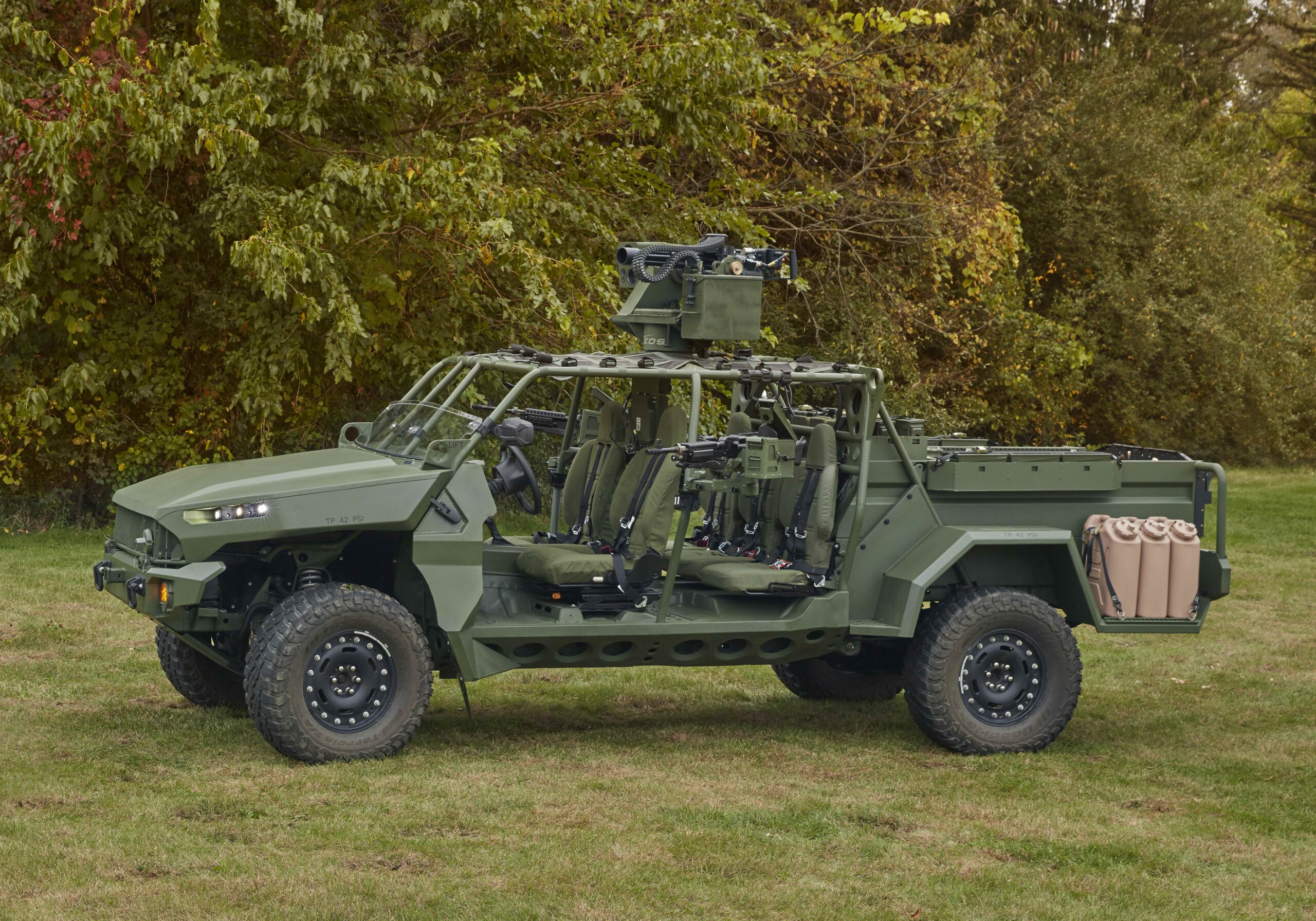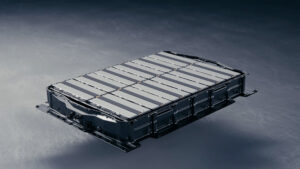
GM Defense integrated GM’s production battery electric technology into its military vehicle and displayed the All-Electric Military Concept Vehicle at AUSA 2021. Photo courtesy of GM Defense.
With new CONOPS required for the Great Power competition, the Government Accountability Office (GAO) canvassed Army leadership to determine what they require from industry to help them modernize their tactical wheeled vehicles (TWV).
Prominent on the list is vehicle electrification, along with a number of other
technologies already being pioneered by the commercial automotive/truck industry. These technologies include: active driver assist safety systems such as collision avoidance; condition-based maintenance and prognostics for vehicle monitoring; autonomy, both semi-autonomous (driver-assisted) and fully autonomous (driverless); fuels, lubricants, and emission-control technology to increase fuel efficiency; and advanced manufacturing to include composites and additive manufacturing.
While most of those other technologies address point aspects of TWV
performance, vehicle electrification covers a wide swath of the modernizations the Army is looking for—from all-electric or hybrid-electric powertrain, anti-idle, and start-stop technology for fuel-demand reduction and silent watch, to exportable power that provides redundancy, replacing diesel generator equipment, and facilitating micro-gridding of multiple vehicles for power during natural disasters when the lights go out. To simplify, this means that Soldiers will have a greater ability to maneuver during silent watch operations. In addition, the lower acoustic signature that battery technology provides will enable stealth capabilities.
The key to introducing electrification and other improvements to TWV is leveraging commercial industry technology advancements, according to the July 2021 GAO report entitled, Tactical Wheeled Vehicles: Army Should Routinely Update Strategy and Improve Communication with Industry.
Recent Army RFIs (Requests For Information) for a Light Electric Reconnaissance Vehicle and new heavy tactical truck, for example, look to industry to identify products, especially those that leverage commercial investments, that can potentially inform development of those TWVs and others.
“Army officials have stated that they are open to seeking more of a customizable, rather than custom-built solution,” the GAO report states. “For example, in pursuing the new Common Tactical Truck and Light Electric Reconnaissance Vehicle, the Army’s requests for information are seeking commercially available solutions before soliciting for specific requirements and capabilities such as autonomy and hybrid or fully-electric powertrains.”
Closer Alliances Will Facilitate Electrification
Based upon GAO’s review of Army documentation and interviews with leadership, it reports that a healthy commercial truck and automotive industrial base can provide the capabilities the Army is seeking for its TWVs. Through the application of commercial technologies to military needs, the Army will gain an ability to rapidly field new capabilities as the industrial base adapts to emerging Army TWV requirements.
To insert these technological advancements into tactical scenarios, the GAO suggests that the Army seek opportunities to consult and collaborate with industry so that the TWV fleet does not diverge from the commercial market to an extent that it can no longer be sustained by the marketplace.
GM Defense has embraced this philosophy promulgating greater teaming and knowledge sharing between the Army and industry. The first fruit of that labor is the nine-soldier Infantry Squad Vehicle (ISV) that GM Defense is manufacturing under a $214 million Army contract awarded in 2020. The ISV is based on the Chevrolet Colorado ZR2 truck.

GM Defense President Steve duMont.
“Clearly we’re going to continue to support our defense customers’ need for advanced, efficient, diesel, internal combustion engines,” said GM Defense president Steve duMont. “At the same time, we are supporting their needs and they transform and drive toward alternative power and propulsion systems that include battery electrification.”
“There will be a long period of time in the defense market where there will be fleets of both electric and internal-combustion-engine-powered vehicles, and we’re here to support both of those fleets.” duMont noted that GM Defense has already adapted electrification to the ISV and displayed what it calls the All-Electric Military Concept Vehicle at the AUSA 2021 show in October. It took GM Defense just three months from concept to completion to build the all-electric vehicle by replacing the internal combustion engine in the traditional nine troop carrier ISV with GM’s current generation battery electric motor. The company is getting valuable feedback from the testing community so that the engineering team can improve future all-electric designs to better meet Soldier needs. The demonstration vehicle also gets GM Defense closer to developing an ecosystem that can support electrification on bases and deliver electrification at the tactical edge.
Part of that ecosystem is addressing how to charge vehicles both on bases and installations where roads are paved, and at the tactical edge in more austere environments. Technically, the base environment can be solved relatively easily by installing electric charging stations and infrastructure in support of rear-echelon operations, where Soldiers plug in their vehicles at the end of the day when they go off duty.
Electric-vehicle operation at the tactical edge is another matter, however. Opportunities to plug in and recharge vehicles won’t or will rarely exist—think Afghanistan. This is where batteries, energy storage, and energy management will be key. GM Defense leaders believe by the time a customer is ready to field an all-electric solution, they will have solved the issue.
Better Batteries Are The Key For Tactical Operations
As said, the tactical edge is the operational environment where commercial-industry development of better batteries will be of particular value to military operations.

Ultium Cells LLC and Li-Cycle enter an agreement to recycle up to 100 percent of the raw materials left over from battery cell manufacturing. Each General Motors Ultium battery module contains 24 battery cells. Each GM Ultium Platform – which will be used in future vehicles such as the GMC HUMMER EV Pickup and SUV and Cadillac LYRIQ – contains between six and 24 battery modules. Photo courtesy of GM Defense.
This is an area of particular strength for GM Defense’s parent company, General Motors (GM), which has pioneered vehicle electrification for more than two decades. Foremost is its research, engineering, and development of energy storage technology, in addition to its third-generation battery technology, Ultium. The Ultium EV battery offers a nearly four-time improvement over current-generation battery technology capable of driving ranges of more than 300 miles on a full charge.
Through the latest research advancements in electrochemistry and related disciplines, the work by GM and others has resulted in a doubling of battery capacity in the past 10 years, with another expected doubling in the next decade.
“We’re seeing battery technology breakthroughs occur every few years, and we’re determined with our investment to stay at the forefront of that development,” said Jim Khoury, GM director of outside sales and new business development for product engineering, speaking about GM’s recently announced $35 billion in investments in vehicle electrification and autonomy.
“Our manufacturing processes are advancing quickly to create higher reliability batteries,” said Khoury. “We’re evolving electrochemistry not only for performance but for economics.”
GM has achieved a 70 percent reduction in cobalt in its Ultium battery technology.
“With the Ultium technology, we’ve engineered the capability to scale up significantly,” said Khoury. “We are looking at the possibility to scale from a compact SUV to an off-road vehicle like the GMC HUMMER EV to military vehicles and commercial applications like the BrightDrop EV600.”
Where Industry Will Lead On Electric Operations
For electrification and battery development disciplines, about half of the challenge is in engineering and half is in manufacturing. Both are needed to be completely successful in the daunting, decades-long quest for better and better electrification.
To address both engineering and manufacturing challenges, GM has invested in two battery cell manufacturing plants in the last year through a joint venture with LG Energy Solution with two more announced. This takes GM’s core, fundamental manufacturing processes and engineering for battery cell manufacturing and brings it further in-house.
“We’ve invested from the ground up to create capability that can be scaled accordingly in GM Defense for their applications,” said Khoury. “They’ll be getting the same high-volume, high-quality automotive-grade product but intended for military customers.”
That will let GM and GM Defense address the mission outcomes that the Army is asking for today and will want in the not-too-distant future. While the Army has not released any specific roadmap for how electrification will be introduced to the fleet, it has expressed interest in silent watch and silent operations.
To assist, GM has conducted simulated missions for the Army and Marine Corps so they can review mission times, mission power, and mission range for what the current technology can do. GM has also employed predictive analysis to show them what future technology can do with the same equipment upgraded.
Said Khoury: “As the Army and Marines become acclimated with electrification, their questions become more and more detailed. That allows GM Defense to follow right behind that learning curve leveraging GM technology and the parent company’s robust EV investments to enable their future missions.”




















